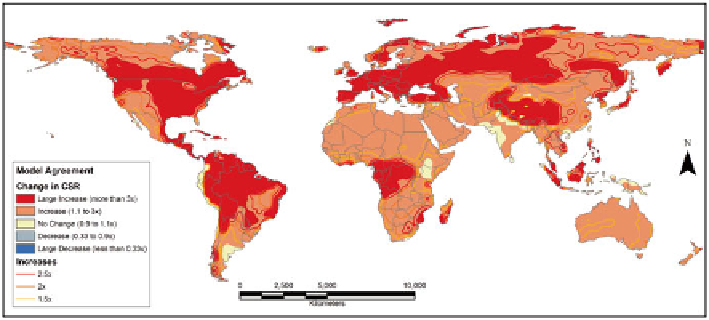Geoscience Reference
In-Depth Information
Fig. 7.2
Cumulative Severity Rating anomalies for the HadCM3 A2 scenario for 2091-2100 rela-
tive to the 1971-2000 base period (See Flannigan et al.
2013
for study design)
the northern hemisphere (Flannigan et al.
2013
). With these increases, we expect more
area burned, increased fi re occurrence, and greater fi re intensity that will result in more
severe fi re seasons and increased fi re control diffi culty. In a Canadian boreal modeling
study, Podur and Wotton (
2010
) estimate that these future conditions will result in an
increase of 200-500 % in annual area burned. The substantial increases in CSR pre-
dicted globally across climate change scenarios by the end of this century (some show-
ing increases of up to 300 %) are truly noteworthy for wildland fi re managers.
7.3
Fire Management and Disaster Fires
Many global regions have reported increasing fi re activity in recent decades, which is
attributed to numerous factors such as climate change-altered fi re regimes, rural-
urban population shifts, and land-use change affecting vegetation and fuel conditions
(Mouillot and Field
2005
; Marlon et al.
2008
; Flannigan et al.
2009a
,
b
). With the vast
amount of fi re that occurs globally, a proportion inevitably becomes uncontrolled
wildfi re of which some have disastrous social, economic, and/or environmental
impacts. The human impacts of wildland fi re are different from other natural disasters
in several ways. Uncontrolled wildland fi res (or wildfi res) can threaten the safety of
many thousands of people, but fortunately, human mortality is much lower (the high-
est current documented mortality is 173 lives lost in the Victoria, Australia, wildfi res
of 2011). However, wildfi res can cause substantial human suffering for large numbers
of people through the loss of shelter, food (crops), fuelwood for cooking, and perhaps
even more crippling, through loss of livelihood (e.g., farm animals, grazing area).
Additionally, the human health impacts from smoke pollution are much more insidi-
ous and long term (Sastry
2002
; Rittmaster et al.
2006
; Goldammer et al.
2009
), and
can be very far-reaching beyond the fi re area itself (DeBell et al.
2004
).

Search WWH ::

Custom Search